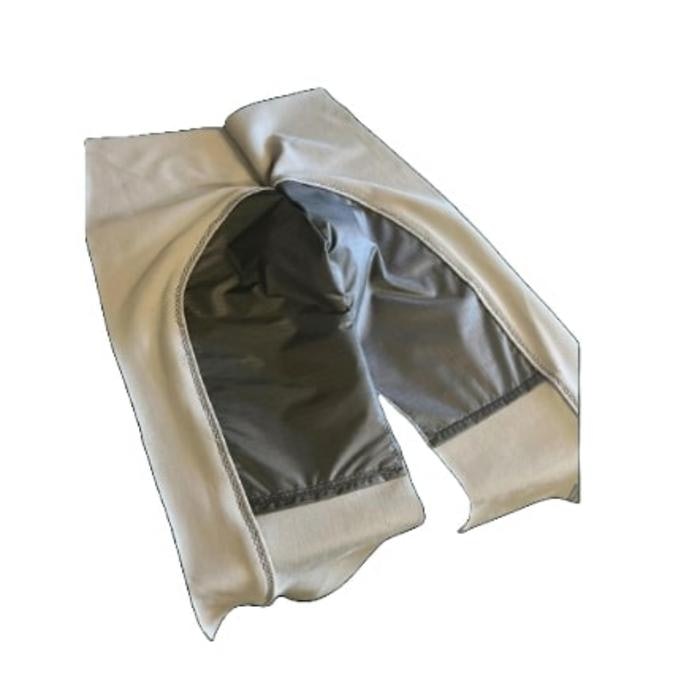
Artemis astronauts may walk the desert surface of the Moon in something very much like the stillsuits from Dune.
In the Dune franchise, the desert-dwelling Fremen survive in the harsh environment of Arrakis thanks to stillsuits: specialized suits that collect and filter every drop of moisture that leaves their bodies, turning it back into drinkable water. Astronauts may eventually use similar technology to survive in an even drier, harsher place than Arrakis: the Moon. Cornell University researchers just unveiled a prototype of a system that would turn a spacesuit into a stillsuit, complete with a urine processor.
Sofia Etlin and her colleagues published their work in the journal Frontiers in Space Technology.

It Goes Under Where?
The prototype system starts with new undergarments, made of several layers of fabric designed to wick fluids (by which we mean astronaut pee) away from the astronaut’s body and into a molded silicone cup, also lined with moisture-wicking fabric. A vacuum pump sucks the urine away and into a filtration system in the astronaut’s backpack, where it’s purified into fresh, drinkable water. From there, the water flows into a drink bag, so the astronaut can enjoy a refreshing drink through a tube in their helmet — likely while trying not to think too hard about where it came from.
Science fiction fans may recognize the concept from Frank Herbert’s meticulously detailed worldbuilding in the Dune novels (which are now in at least their third round of screen adaptations). On the desert planet Arrakis, the indigenous Fremen wear specialized deserts survival called stillsuits, whose several layers of fabric absorb and reprocess every single droplet of water that leaves the body, which includes not only urine, but also sweat and even exhaled moisture. The purified water is pumped to “catch pockets” around the body.
“With a Fremen suit in good working order, you won't lose more than a thimbleful of moisture a day,” planetologist Liet Kynes tells Duke Leto Atreides in the book.
Etlin and her colleagues’ prototype isn’t nearly that efficient; it reclaims about 87 percent of astronauts’ water. But it’s fast: It can purify about 16 ounces of urine in about five minutes.

Waste Not, Want Not
Despite the resemblance to science fiction, Etlin and her colleagues’ prototype suit isn’t that far-fetched. Modern astronauts already drink their own (and their crewmates’) urine aboard the International Space Station, where the station’s toilets collect it and pump into processors for purification. The long-detained Starliner crew recently helped swap out parts in one of those urine processor pumps, which produce about 90 percent of the station’s drinking water.
NASA wants to get that figure to about 98 percent before it sends astronauts to Mars, so spacecrafts can re-stock their own water supplies in transit.
Meanwhile, Etlin and her colleagues want to solve a different problem: making sure astronauts have enough to drink, along with a handy way to dispose of used beverages, while they’re on long walks across the lunar surface.
“Astronauts currently only have 1 liter of water available in their in-suit drink bags,” says Cornell University engineer Sofia Etlin in a recent statement. “This is insufficient for the planned, longer-lasting lunar spacewalks which can last up to 10 hours — and even up to 24 hours in an emergency.”
If the prototype takes off, it would replace the space diapers (formerly known as Maximum Absorbency Garments, or MAGs) that astronauts have worn under their suits since around 1978. MAGs, in turn, replaced the old urine-collection device, which was a condom-like cuff connected to a holding bag, which early astronauts wore under their pressure suits. Buzz Aldrin claims to have used his UCD just moments after stepping onto the lunar surface in 1969.
(Fun fact: I wrote a whole book about how astronauts use the bathroom in space, and you can find it here.)
NASA switched to MAGs when the first women joined the astronaut corps in 1978. They’re an elegantly simple solution, if you can use words like “elegant” to describe what’s basically an over-engineered diaper, but they’re not perfect. MAGs are good for about 10 hours, but after that, a soaked MAG can turn into a messy problem. And whatever urine goes into a MAG is lost forever.
So far, NASA doesn’t have any plans to ditch the diapers. Unless something changes, Artemis crews will be wearing MAGs on the Moon.
“Sometimes simplicity is best,” said Russell Ralston, deputy program manager for Extravehicular Activity at Axiom Space, during a March 2023 press conference about NASA’s new Artemis Lunar Surface Suits. But Etlin and her colleagues are hoping to change that. Now that they have a working prototype, their next step will be to test the system in microgravity.







